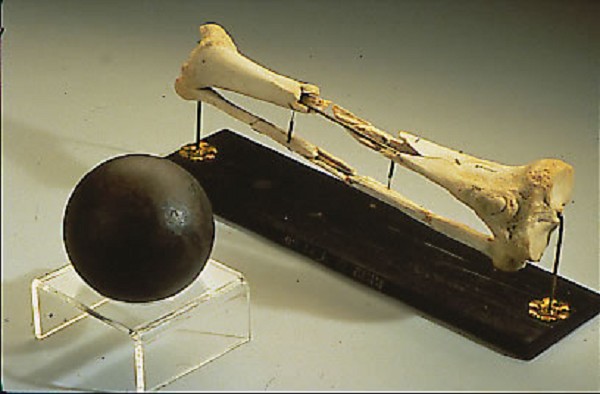
Bones from Daniel Sickles' leg severed by a rebel cannonball at Gettysburg are displayed at the Army Medical Museum in Washington. HISTORY QUIZ? Is There a Bay City Connection in Spielberg's Movie, Lincoln?
November 27, 2012
Leave a Comment
|
||||||||||
| Printer Friendly Story View |
The movie "Lincoln," directed by Steven Spielberg, has been praised for its historical accuracy down to a strange scene in which Congressmen are being touted for votes in a medical museum.
The gruesome view of a severed, embalmed leg is shown in a glass case, a scene not quite as horrific as one that came later in the film -- the dumping of a cart full of severed body parts from amputations as Robert Lincoln watches.
The leg shown in the case was that of Maj. Gen. Daniel Sickles, commander of III Corps in the Union Army at the Battle of Gettysburg.
In 1897, the one-legged Sickles visited Bay City on the Presidential campaign train of William McKinley, Republican candidate. The former general was unable to appear on the platform at the station on First Street, but McKinley made sure the crowd knew the self-proclaimed war hero was with his entourage.
Sickles not only concocted his own version of his performance in the battle and had it published in a New York newspaper under a pseudonym but also connived to be awarded the Congressional Medal of Honor some 34 years after the war.
A blogger comments: "Congressman Sickles became famous in 1859 for stalking and killing his wife's lover (the son of Francis Scott Key) and then was acquitted of murder using the first temporary insanity plea in U.S. history.
"To improve his image, he took a leadership position in the Union army during the Civil War. Willfully disobeying commands, (issued by Maj. Gen. George G. Meade) Sickles led his unit into an vulnerable position at Gettysburg.
"In this battle, his troops were routed and his leg was fractured by a cannonball. After the amputation, Sickle donated the leg to the Army Medical Museum as an oddity of war. A body part wounded in battle from an infamous politician would no doubt have attracted local attention and so it is totally unsurprising that a Congressman was found there observing the piece in the film."
The loss of Sickles' leg came the second day of a three day battle at Gettysburg, 2 July 1863. The cantankerous corps commander was carried from the field, reportedly still barking orders from his stretcher while chomping on a cigar.
His replacement was Maj. Gen. David Bell Birney, who had spent part of his youth in Bay City with his father, pioneer James G. Birney, a noted abolitionist who had run twice for President on the Liberty Party ticket.
David Birney himself was something of a Bay City pioneer, at age 17 having driven a herd of thoroughbred cattle 300 miles from Ohio. He later represented a Philadelphia mercantile company selling to the Indians in the area and also owned property on Jefferson Street.
Gen. Birney, himself an abolitionist, was not given credit for his perilous task in leading Sickles' men in defending the tenuous position against heavy attacks by rebel forces. Even the famed Lt. Gen. James Longstreet, noted as "Lee's Warhorse," personally led an assault on the Wheat field and the Peach Orchard.
In researching for my book "Apostles of Equality: The Birneys, the Republicans and the Civil War," it appeared that Gen. Birney was dealt grievous injustice by historians. Abolitionists were unpopular even at the North and Birney was attacked during the war by news reporters and later by commentators on the Civil War.
Even today, bloggers perpetuate the anti-David Birney message, one recent posting by a self-appointed "expert" accusing him of "childlike behavior" during the battle and "self-loathing" afterward.
However, the present official Gettysburg Battlefield historian has written that Birney's troops steadfastness was in fact the key to the Union success.
Sickles, a Tammany Hall Democrat who turned Republican after the election of Abraham Lincoln, was a notorious ladies' man and was involved in many scandals. However, he is credited with providing the inspiration for Central Park in New York City. He was forced out of a longtime post on the New York Monuments Commission after embezzling $27,000. He died in 1914.
| Printer Friendly Story View |
|
|

Dave Rogers |
|
|
|
Printer-Friendly Story View
0200 Nd: 04-15-2024 d 4 cpr 0
12/31/2020 P3v3-0200-Ad.cfm
SPONSORED LINKS
12/31/2020 drop ads P3v3-0200-Ad.cfm


